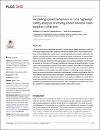Modelling speed behaviour in rural highways: Safety analysis of driving under adverse road-weather conditions
الملخص
This study proposes a methodical approach to model desired speed distributions under different road-weather and traffic conditions followed by identification of road-weather conditions with potentially higher safety risks in rural divided highways located in extremely cold regions. Desired speed distributions encompassing unique combinations of adverse road-weather and traffic conditions are modelled as normal distributions characterized by their means and standard deviations formulated based on two principal statistical theorems and techniques i.e., Central Limit Theorem and Minimum Variance Unbiased Estimation. Combination of the precipitation conditions, road surface conditions, time of the day, temperature, traffic flow and the heavy vehicle percentage at the time of travel were considered in defining the combinations of road-weather and traffic conditions. The findings reveal that simultaneous occurrence of particular precipitation and pavement conditions significantly affect the characteristics of the desired speed distribution and potentially expose drivers to elevated safety risks. Jurisdictions experiencing extreme road-weather conditions may adapt the proposed methodology to assess speed behaviour under different road-weather conditions to establishing and deploying weather-responsive traffic management strategies such as variable speed limit to regulate speeding and improve traffic safety in winter.
معرّف المصادر الموحد
https://www.scopus.com/inward/record.uri?partnerID=HzOxMe3b&scp=85112756313&origin=inwardالمجموعات
- السلامة المرورية [163 items ]


